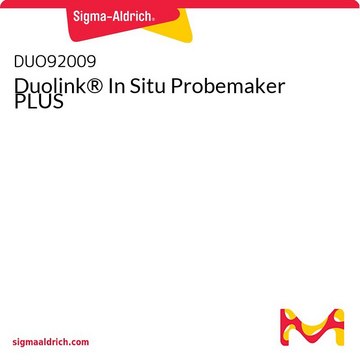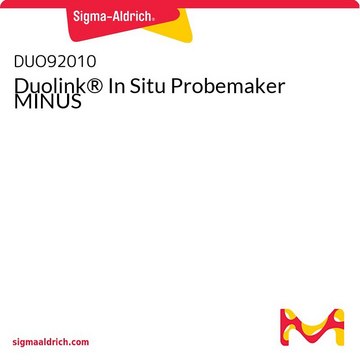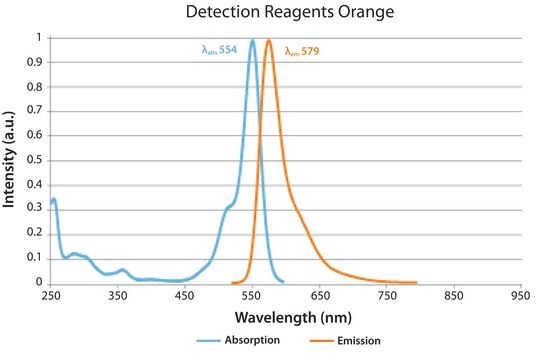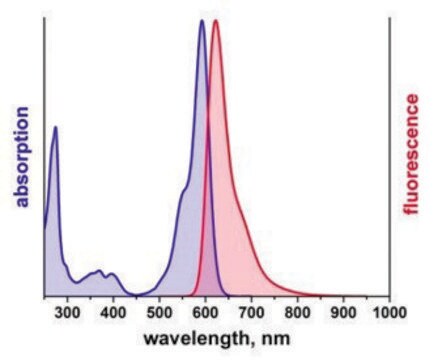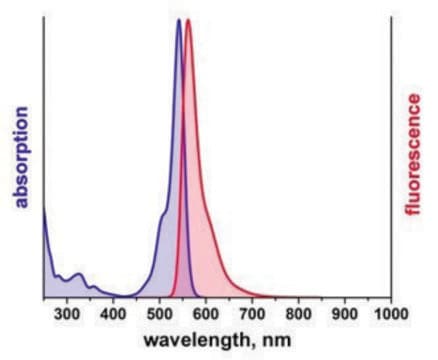DUO96001
Duolink® flowPLA Multicolor Reagent Pack
Duolink® PLA kit for Flow Cytometry Multiplexing
About This Item
Produits recommandés
Niveau de qualité
Gamme de produits
Duolink®
Technique(s)
flow cytometry: suitable
immunofluorescence: suitable
multiplexing: suitable
proximity ligation assay: suitable
Conditions d'expédition
dry ice
Température de stockage
−20°C
Catégories apparentées
Spécificité
Duolink® flowPLA Multicolor Reagent Pack contains all the necessary reagents to perform the amplification and detection of bound custom PLA probes generated using Duolink® PLA Multicolor Probemaker Kits. Sufficient components are provided for approximately 40 tests at 100 μL reaction volume.
Application
Duolink® Multicolor flow PLA Reagent Pack Kits used with Duolink® PLA Multicolor Probemaker Kits will enable Multiplexing of up to 4 protein events with sensitive detection of proteins, protein-protein interactions, and protein modifications within cell populations by flow cytometry. To perform a Duolink® flowPLA experiment, you will need fixed and permeabilized suspended cells, and at least two primary antibodies that specifically recognize your proteins of interest. Analysis is carried out using standard flow cytometry assay equipment. User must provide a fixed cell suspension and primary antibodies.
Application Note
Primary antibodies are needed. Test your primary antibodies (IgG-class, mono- or polyclonal) in a standard immunofluorescence (IF), immunohistochemistry (IHC) or immunocytochemistry (ICC) assay to determine the optimal fixation, blocking, and titer conditions. Duolink® in situ reagents are suitable for use on fixed cells, cytospin cells, cells grown on slide, formalin-fixed, paraffin embedded (FFPE), or tissue (fresh or frozen). Flow validated antibodies are recommended. It is also highly recommended that users purchase our Duolink(insert registration symbol) Compensation Beads (make title a hyperlink to beads products) to inform experimental design, instrument settings, and assist with compensation parameters.
Let us do the work for you, learn more about our Custom Service Program to accelerate your Duolink® projects
View full Duolink® product list
Caractéristiques et avantages
- Visualize and detect multiple proteins events in one experiment
- No overexpression or genetic manipulation required
- High specificity (fewer false positives)
- Detection of low abundant proteins due to rolling circle amplification
- Relative quantification possible
- No special equipment needed
- Faster and more simple than FRET
- Publication-ready results
Composants
- 5x Multicolor PLA Ligation Buffer (DUO86002)
- 5x Amplification Buffer (DUO82050)
- 5x Multicolor FlowPLA Detection Buffer (DUO86003)
- 1x Ligase (DUO82025)
- 1x Polymerase (DUO82026)
- 1x Blocking Solution (DUO82007)
- Duolink Probemaker PLA Probe Diluent (DUO82036)
See datasheet for more information.
Informations légales
Mention d'avertissement
Warning
Mentions de danger
Conseils de prudence
Classification des risques
Aquatic Chronic 2 - Skin Sens. 1
Code de la classe de stockage
10 - Combustible liquids
Faites votre choix parmi les versions les plus récentes :
Certificats d'analyse (COA)
Vous ne trouvez pas la bonne version ?
Si vous avez besoin d'une version particulière, vous pouvez rechercher un certificat spécifique par le numéro de lot.
Déjà en possession de ce produit ?
Retrouvez la documentation relative aux produits que vous avez récemment achetés dans la Bibliothèque de documents.
Notre équipe de scientifiques dispose d'une expérience dans tous les secteurs de la recherche, notamment en sciences de la vie, science des matériaux, synthèse chimique, chromatographie, analyse et dans de nombreux autres domaines..
Contacter notre Service technique

